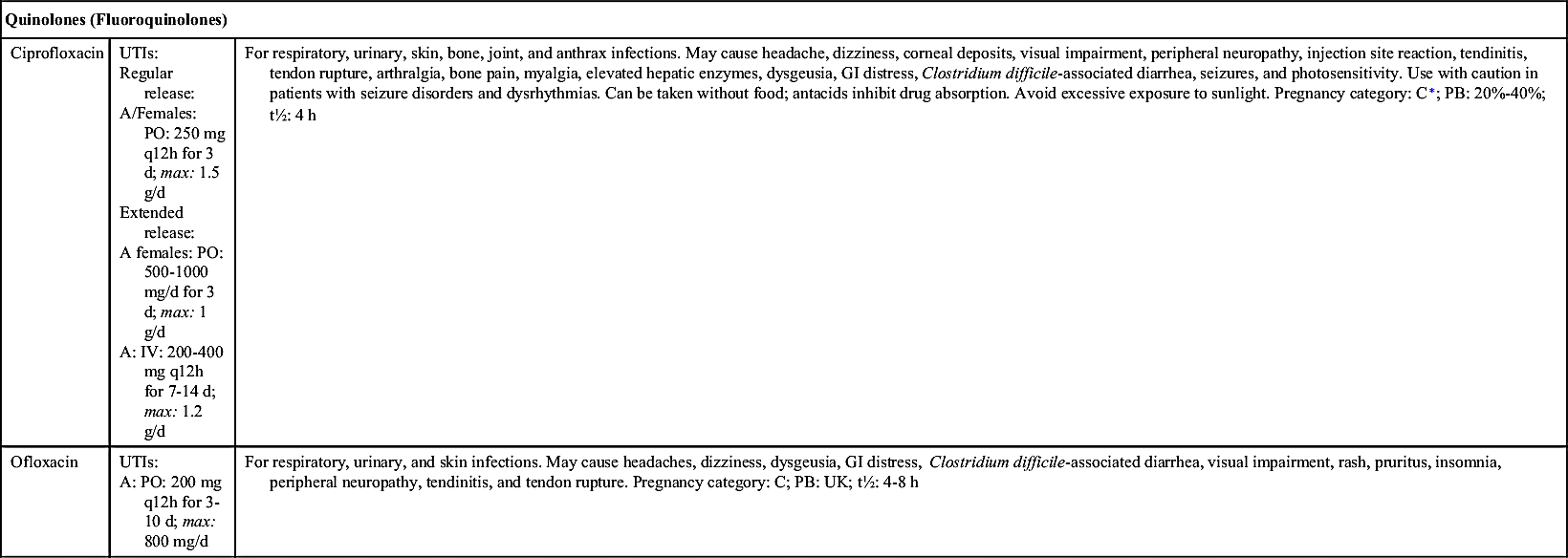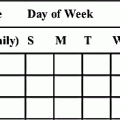http://evolve.elsevier.com/McCuistion/pharmacology
The largest number of urinary tract disorders is caused by urinary tract infections (UTIs), microbial infections of any part of the urinary tract. The infection may be referred to as an upper UTI, such as pyelonephritis, or a lower UTI, such as cystitis, urethritis, or prostatitis. A group of drugs called urinary antiseptics/antiinfectives prevents bacterial growth in the kidneys and bladder, but these drugs are not effective for systemic infections. When given in lower dosages, urinary antiseptics/antiinfectives have a bacteriostatic effect—that is, they inhibit bacterial growth. When given in higher dosages, they also have a bactericidal (bacteria killing) effect. Urinary antiseptics/antiinfectives are presented in this chapter, along with urinary analgesics, which relieve pain and burning in the urinary tract; urinary stimulants, agents that increase the tone of urinary muscles; and urinary antispasmodics/antimuscarinics. Chapter 26 presents further discussions of antibiotics used to treat UTIs, such as fluoroquinolones and sulfonamides. Diuretics are discussed in Chapter 38.
Acute cystitis, a lower UTI, frequently occurs in female patients because of the short urethra. It is more common in women of childbearing age, older women, and young girls. Acute cystitis is commonly caused by Escherichia coli (also called E. coli). Other bacterial causes include the gram-positive Staphylococcus saprophyticus and gram-negative Klebsiella, Proteus, and Pseudomonas species. Symptoms of cystitis include pain and burning on urination and urinary frequency and urgency. A urine culture is usually obtained before the start of any antiinfective/antibiotic drug therapy. In male patients, a lower UTI is most likely prostatitis with symptoms similar to cystitis.
Acute pyelonephritis, an upper UTI, is commonly seen in women of childbearing age, older women, and young girls. E. coli is the most common organism to cause pyelonephritis. Symptoms include chills, high fever, flank pain, pain during urination, urinary frequency and urgency, and pyuria. The bacterial count in the urine is greater than 100,000 bacteria/mL. In severe cases, the patient may be hospitalized and may receive intravenous (IV) antibiotics (e.g., an aminoglycoside or piperacillin-tazobactam).
The most commonly used agents for treating UTIs are nitrofurantoin and trimethoprim-sulfamethoxazole. Treatment may consist of a single double-strength dose of the chosen drug, a 3-day course, or the traditional method of 7 to 14 days of drug dosing. Fosfomycin tromethamine, a nitrofurantoin prototype drug, is effective for UTIs as a single-dose treatment. Other agents used to treat UTIs include third-generation cephalosporins (cefixime, cefpodoxime proxetil, or ceftibuten), fourth-generation cephalosporins (cefepime), fifth-generation cephalosporins (ceftolozane-tazobactam), and fluoroquinolones, such as ofloxacin, ciprofloxacin, and levofloxacin. For uncomplicated UTIs, fluoroquinolones, especially levofloxacin, may be used only when other options are not available. With severe UTIs, IV drug therapy followed by oral drug therapy is usually recommended.
Urinary Antiseptics/Antiinfectives and Antibiotics
Urinary antiseptics/antiinfectives are limited to the treatment of UTIs. Drug action occurs in the renal tubule and bladder, where it is effective in reducing bacterial growth. A urinalysis, as well as a culture and sensitivity test, is usually performed before the initiation of drug therapy. As bactericidal agents, these drugs have the potential to cause superinfections. The urinary antiseptics/antiinfectives are fosfomycin tromethamine, nitrofurantoin, methenamine hippurate, trimethoprim, ertapenem, and the fluoroquinolones.
Nitrofurantoin
Nitrofurantoin was first prescribed to treat UTIs in 1953. It is bacteriostatic or bactericidal, depending on the drug dosage, and it is effective against many gram-positive and gram-negative organisms, especially E. coli. It is used to treat cystitis and UTIs.
Pharmacokinetics
Nitrofurantoin is well absorbed from the gastrointestinal (GI) tract. The drug is usually taken with food to decrease GI distress, which includes anorexia, nausea, vomiting, abdominal pain, and diarrhea. Decreased absorption occurs when the drug is taken with antacids. Nitrofurantoin is moderately protein bound. With normal renal function, the drug is rapidly eliminated because of its short half-life of 20 minutes; however, it accumulates in the serum with urinary dysfunction.
Pharmacodynamics
When nitrofurantoin is given in low doses for prophylactic use, the drug has a bacteriostatic effect. However, higher concentrations of nitrofurantoin cause a bactericidal effect, and it is effective against many gram-positive and gram-negative organisms such as E. coli, Staphylococcus aureus, streptococci, and Neisseria and Klebsiella species. The onset and duration of action are unknown. Peak action occurs 30 minutes after absorption. If sudden onset of dyspnea, chest pain, cough, fever, and chills develops, the patient should contact the health care provider. Symptoms resolve after discontinuing the drug.
The nursing process for nitrofurantoin is applicable to the other urinary antiseptics/antiinfectives.
 Cultural Considerations
Cultural Considerations• Alleviate fears or concerns of patients from different cultural backgrounds. Use culturally consistent communication when explaining the treatment regimen for a UTI. An interpreter may be necessary. The use of pamphlets in the language the patient reads or speaks most easily can facilitate patient understanding.
Evaluation
• Evaluate the effectiveness of the urinary antiinfectives in alleviating UTI. The patient should be free of side effects and adverse reactions to the drug.
Methenamine
Methenamine produces a bactericidal effect when the urine pH is less than 5.5. It is effective against gram-positive and gram-negative organisms, especially E. coli, Enterococcus and Proteus species, and Pseudomonas aeruginosa. It is used for chronic UTIs. Methenamine should not be taken with sulfonamides because crystalluria is likely to occur. Methenamine is absorbed readily from the GI tract, and approximately 90% of the drug is excreted in the urine unchanged. Methenamine forms ammonia and formaldehyde in acid urine, therefore the urine needs to be acidified to exert a bactericidal action. Cranberry juice (several 8-ounce glasses per day), ascorbic acid, and ammonium chloride can be taken to decrease the urine pH.
Trimethoprim and Trimethoprim-Sulfamethoxazole
Trimethoprim can be used alone for the treatment of UTIs, but it is usually used in combination with a sulfonamide, sulfamethoxazole (the combined generic preparation is called TMP-SMZ), to prevent the occurrence of trimethoprim-resistant organisms. This drug combination produces slow-acting bactericidal effects against most gram-positive and gram-negative organisms, especially strains of S. aureus, including methicillin-resistant S. aureus (MRSA), and also Shigella and Proteus species. TMP-SMZ is discussed further in Chapter 26 and it is used in the treatment and prevention of acute and chronic UTIs. The amount of TMP-SMZ in the prostatic fluid is about two to three times greater than the amount in the vascular fluid. The half-life of TMP-SMZ is normally 6 to 12 hours, but it is longer in patients with renal dysfunction.
Fluoroquinolones (Quinolones)
Fluoroquinolones are one of the groups of urinary antibacterials that are effective against strains of Acinetobacter, Chlamydia, Clostridium, Klebsiella, Staphylococcus, and Streptococcus species that cause lower UTIs; they include ciprofloxacin, ofloxacin, and levofloxacin. Fluoroquinolones should be reserved for patients who have no alternative treatment options due to their harsh adverse reactions of tendon rupture, peripheral neuropathy, central nervous system effects, and exacerbation of myasthenia gravis. The drug dosage must be decreased when renal dysfunction is present. The half-lives of these drugs are ordinarily 2 to 8 hours, but half-lives are prolonged in patients with renal dysfunction. Table 48.1 lists the urinary antiseptics/antiinfectives and their dosages, uses, and considerations. Due to the serious adverse reactions of fluoroquinolones, they are used with caution for complicated UTIs and acute pylonephritis and levofloxacin is only used for uncomplicated UTIs when no other options are available. Levofloxacin is illustrated in Prototype Drug Chart 26.6.
Side Effects and Adverse Reactions
Nitrofurantoin
Side effects of nitrofurantoin include GI disturbances such as anorexia, nausea, vomiting, diarrhea, and abdominal pain and pulmonary reactions such as dyspnea, chest pain, and cough.
Methenamine
Methenamine has side effects that include nausea, dysuria, hematuria, and crystalluria.
Trimethoprim-Sulfamethoxazole
GI symptoms such as anorexia, nausea, and vomiting and skin problems such as rash and pruritus can accompany trimethoprim-sulfamethoxazole use.
Fluoroquinolones
Side effects of ciprofloxacin and ofloxacin include headaches, photosensitivity, dizziness, nausea, vomiting, diarrhea, visual impairment, rash, and pruritus. Serious adverse reactions include peripheral neuropathy, tendinitis, and tendon rupture. Fluoroquinolones may exacerbate muscle weakness in patients with myasthenia gravis. Direct patients to stop taking fluoroquinolones immediately if experiencing serious adverse reactions and notify health care provider.
Drug-Drug Interactions
The following drug-drug interactions can occur with the use of urinary antiseptics/antiinfectives:
• Antacids decrease nitrofurantoin absorption.
• Sodium bicarbonate inhibits the action of methenamine.
• Methenamine taken with sulfonamides increases the risk of crystalluria.
• Most urinary antiseptics cause false-positive Clinitest (glucose urine test) results.
Urinary Analgesics
Phenazopyridine
Phenazopyridine hydrochloride, an azo dye, and dimethyl sulfoxide (also called DMSO) are urinary analgesics that are used to relieve the urinary pain, burning sensation, frequency, and urgency of urination that are symptomatic of cystitis. Phenazopyridine can cause GI disturbances such as abdominal cramps, hemolytic anemia, and renal and hepatic dysfunction. The urine becomes a harmless reddish orange because of the phenazopyridine dye. Phenazopyridine can alter the glucose urine test (Clinitest), therefore a blood test should be used to monitor glucose levels. Dimethyl sulfoxide may cause a garlic-like taste and skin hyperpigmentation.
Urinary Stimulants
When bladder function is decreased or lost as a result of (1) a neurogenic bladder (a dysfunction caused by a lesion of the nervous system), (2) a spinal cord injury (paraplegia, hemiplegia), or (3) a severe head injury, a parasympathomimetic may be used to stimulate micturition (urination). The drug of choice, bethanechol chloride, is a urinary stimulant also known as a direct-acting parasympathomimetic. The drug action is to increase bladder tone by increasing tone of the detrusor urinal muscle, which produces a contraction strong enough to stimulate urination. Bethanechol is discussed in detail in Chapter 16.
Urinary Antispasmodics/Antimuscarinics/Anticholinergics
Urinary tract spasms resulting from infection or injury can be relieved with antispasmodics that have a direct action on the smooth muscles of the urinary tract. This group of drugs—mirabegron, oxybutynin, and flavoxate—is contraindicated for use if urinary or GI obstruction is present or if the patient has glaucoma. Antispasmodics have the same effects as antimuscarinics, agents that block parasympathetic nerve impulses; parasympatholytics; and anticholinergics (see Chapter 16). Tolterodine tartrate, trospium chloride, and solifenacin succinate are antimuscarinic/anticholinergic drugs used to control an overactive bladder, which causes frequency in urination. These drugs also decrease urgency and urinary incontinence. Antispasmodics/antimuscarinics/anticholinergics frequently have side effects including blurred vision, headache, dizziness, dry mouth, constipation, and tachycardia. The patient taking these drugs should be taught to report urinary retention, severe dizziness, blurred vision, palpitations, and confusion. Table 48.2 lists drugs that are urinary analgesics, stimulants, and antispasmodics/antimuscarinics/anticholinergics.
Critical Thinking Case Study
FL, a 29-year-old woman, has complained to her health care provider of painful urinary frequency and urgency. The patient has an elevated temperature. A urine specimen indicates that FL has a urinary tract infection (UTI). The health care provider prescribes trimethoprim-sulfamethoxazole (TMP-SMZ) double-strength tablets (trimethoprim 160 mg, sulfamethoxazole 800 mg) twice a day for 14 days.
1. What other information should the health care provider obtain from the patient?
2. Why was TMP-SMZ prescribed? Explain your answer.
3. What should the health care provider discuss with the patient in regard to taking the drug and its possible side effects? What other information should FL receive?
4. What is the recommended time for follow-up care for FL?
5. What other drugs might be used instead of TMP-SMZ? Would one urinary antiinfective drug be more effective than another? Explain your answer.















